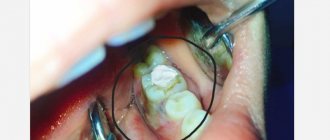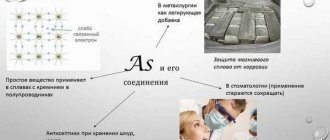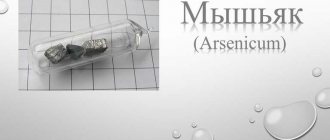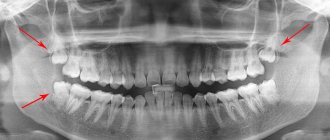11298
Dental clinics use modern means for dental treatment that do not harm the patient’s health. Most of them can even be used to treat children and pregnant women.
But despite the variety of these drugs, in the dentist’s office you can still find outdated arsenic, which was used at the beginning of the development of the field of dentistry.
Most often it is used in free economy class clinics for multi-stage tooth treatment for pulpitis.
General information about the drug
Arsenic is a chemical element located at 33rd place in the periodic table. It is a brittle semi-metal that easily breaks down into smaller particles under mechanical stress.
Arsenic has a rich steel color with greenish inclusions. Belongs to the group of toxic drugs (level 3.4), has been successfully used in the fight against rodents. Since the beginning of the 19th century, the drug has found its use in dental practice.
Back then, dentists used it in its pure, unchanged form as an anesthetic. It was later discovered that pure arsenic aggravated dental disease and irreversibly destroyed soft tissue and jawbone structure due to high permeability.
In this regard, in the 20th century, they began to practice the use of arsenous acid instead of a pure substance, which made it possible to maintain the integrity of patients’ teeth.
Complications
Since arsenic is a toxic substance, its use in dental practice should be limited. As a rule, doctors do not use devitalizing pastes based on it for extensive inflammation of the pulp involving an entire group of teeth.
This is due to the fact that this substance can accumulate in the tissues surrounding the affected tooth, and over time lead to their inflammation. This does not exclude the general effect of the drug on the body .
A complication is the death of tissue in the area of the treated tooth. The instructions included with the paste indicate that a single dose cannot exceed 0.0008 g. In practice, the calculation is approximate, without taking into account the characteristics of each patient.
The amount of mass usually does not exceed the head of a pin. But if a filling with arsenic is removed too late, even this amount is enough to cause tissue necrosis and periodontal inflammation.
Premature removal or loss of a filling can also lead to complications. In this situation, the risk of ingesting arsenic increases, which causes acute poisoning with impaired functioning of the liver and digestive organs.
With the high professionalism of the dentist, these complications are minimized. Most often in dental practice, cases of complications are recorded when trying to independently apply arsenic paste at home .
Such experiments end in gum burns, which will have to be treated in the clinic.
Indications
Indications for the use of anesthetic drugs based on arsenic:
- impossibility of using other anesthetics (for a number of indications);
- resistance to other local anesthetics;
- inability to use local or conduction anesthesia (for a number of indications);
- treatment of older children (provided the root system is formed);
- sharp throbbing pain in the affected area of the tooth.
The advisability of using arsenic paste is determined by the doctor after assessing the patient’s oral cavity, the stage of tooth damage, the severity of symptoms and studying the patient’s medical history.
Read about which dental crowns are best and the indications for different types. This article describes what pathology a black hairy tongue indicates.
Follow this link for complete information about the treatment of submandibular lymphadenitis.
Problems when installing a filling with arsenic
You cannot overexpose a filling with arsenic. The timing is set by the attending physician. Many people make a big mistake when the pain subsides and do not rush to see a doctor. It's in vain. Paste containing arsenic can cause tissue cell death. If the filling is applied poorly, necrosis may occur:
- Bone tissue.
- Gums.
- Alveolar bone.
If the filling is accidentally displaced, it can result in a serious gum burn from arsenic acid. In this case, you should urgently take hydrogen peroxide and rinse the affected area, then sprinkle with magnesium. To prevent arsenic from affecting the gums, first lubricate it with iodine tincture.
Remember! Under no circumstances should you keep arsenic in your teeth, otherwise the pulp may become very swollen or you will be seriously poisoned. Sometimes an overdose of arsenic leads to acute periodontitis. In this situation, the root and coronal pulp are immediately removed, then the root canals are thoroughly disinfected.
We suggest you familiarize yourself with remedies for sore throat: spray, solution, tablets
Contraindications for use
Despite the fact that arsenic is used in small doses, there are a number of contraindications for use:
- individual intolerance to arsenic or other components of the paste;
- early childhood (up to 1.5 - 2 years);
- aggravated clinical history of the patient (anomalies in the development of organs and systems, pathological conditions);
- incomplete process of root system formation;
- impossibility of expansion and drainage of root canals;
- abnormal structure of the root system;
- osteoperforation of the root and hilar region;
- chronic increase in intraocular pressure (risks of developing glaucoma);
- diseases of the urinary system (pyelonephritis, hydronephrosis, cystitis, prostatitis, etc.);
- gestational period in women (all trimesters) and lactation.
The use of arsenic should be carried out in strict accordance with the recommended dosage. When applying arsenic paste, it is important to follow the advice of specialists and be sure to comply with the treatment time frame.
Why arsenic in dentistry
The use of arsenic is not very common now; modern treatment is carried out with arsenic-free pastes that contain an analgesic. After this paste is applied to the nerve, it should remain for several days. Throughout this period, the crown does not hurt, the nerve gradually dies, then it is also painlessly removed.
In case of severe carious destruction of the crown or in cases of pulpitis, the dentist will perform depulpation.
The dental nerve will be removed with arsenic in the following cases:
- contraindications to anesthesia, allergies to painkillers;
- characteristics of the body when existing anesthetics do not work;
- emergency dental treatment.
Arsenic cannot be used for treatment in the following cases:
- age up to 2 years;
- arsenic intolerance;
- poor access to the dental cavity;
- root disconnection;
- increased intraocular pressure;
- tooth root disease;
- systemic diseases of the genitourinary system.
Paste with or without arsenic is used only when pain relief cannot be performed. As soon as arsenic is added and a temporary filling is placed, the dental nerve begins to gradually die, causing the organ to hurt for some time, it may be painful to press on it and it reacts to temperature stimuli. After applying the arsenic paste, it should remain in the tooth for 24 to 48 hours.
We invite you to familiarize yourself with How to treat seizures in the corners of the mouth: TOP 5 ointments for treatment at home
If for some reason you cannot visit the dentist after the specified time to remove the nerve, complications may arise, even to the point where you will have to have the crown removed. To prevent this, you need to properly plan the treatment and do everything according to the dentist’s instructions.
Active composition and auxiliary components
Arsenic pastes are classified according to the type of purpose and the ratio of the proportions of the constituent substances, but almost all pastes have a similar composition:
- Arsenic anhydride. An active substance with a pronounced necrotic effect on soft tissues, promoting the rapid death of the pulp.
- Anesthetic components (no more than 30%). Dicaine, widely known among substances for surface anesthesia, is most often used. Dicaine quickly relieves areas of pain and has a prolonged anesthetic effect.
- Antiseptics. When making paste, thymol or carbolic acid is often used. Antiseptic substances inhibit the development of pathogenic microflora and prevent them from entering the pulp area.
- Astringent component (tannin). The drug is included in the composition for the prolonged action of the drug, allowing for planned treatment 2 - 3 days after the application of the arsenic composition.
Definition
Arsenic, or scientifically called arsenum, is the 33rd element in Mendeleev’s periodic table and belongs to substances that have a pronounced toxic effect .
Once this substance was used only for baiting rodents , but later scientists developed arsenic anhydride based on it, which could be used in medical practice.
In dentistry, anhydride is not used in its pure form, but as part of devitalizing pastes, where it occupies a third of the total mass. In addition to arsenic, it also contains a number of additional substances:
- an anesthetic component, which can be lidocaine, novocaine or dicaine;
- an aseptic component such as thymol, camphor or carbolic acid;
- tannin is a prolonging component that allows the paste to act directly on the nerve, excluding penetration into surrounding tissues;
- filler , due to which the paste holds its shape when rolled into a ball.
Impact on the lesion
Arsenic has a pronounced necrotic effect on living tissues of the dental structure and rhizomes. It has a cytotoxic effect on tissue cells, disrupting their full oxygen supply.
As a result of the penetration of toxic elements into the protein structure of the pulp, normal blood supply in the root zone is stopped. Thanks to denaturation, the transmission of pain impulses from the nerve endings of the tooth to the central nervous system is completely (sometimes partially) blocked.
The necrotic process is accompanied by aching pain of varying intensity at the site of tooth damage. With a multi-rooted tooth, the pain can be widespread.
When is it necessary to remove a nerve?
Dentists are trying their best to save the tooth, but, unfortunately, this is not always possible. For example, in case of extensive caries, it is necessary to resort to removing the nerve of the tooth. The nerve (pulp) is responsible for the sensitivity of the unit. Pain and other unpleasant symptoms arise precisely because of inflammation of the pulp. The following conditions are considered the main indications:
- Advanced periodontitis.
- Deep caries affecting the internal tissues of the tooth.
- Acute pulpitis.
Also, this manipulation is indicated in cases where crowns, bridges, veneers and other fixed prostheses are to be installed. First of all, this is done with the intention that the tooth does not get sick under the artificial structure. In this case, the unit is considered dead, but continues to perform its functional duties.
Usage algorithm
The application of the drug and temporary filling is carried out in 3 stages:
- pulp opening;
- removal of damaged dentin;
- application of arsenic paste.
For single-rooted teeth, the duration of application reaches 24 hours, for multi-rooted teeth - 48 hours. Once the installation is complete, the doctor will schedule the next appointment.
The next appointment should be scheduled no later than the time it is safe to wear a temporary filling with arsenic. Leaving the paste in the tooth cavity threatens serious complications and can provoke further destruction.
Nerve removal in children and pregnant women
Pulp removal surgery is not scary, but it is surgery nonetheless. There are separate conditions for its implementation for children and expectant mothers.
Removal of the nerve of baby teeth is carried out extremely delicately so as not to damage the buds of the main teeth. Therefore, after depulpation, it is not the canals themselves that are sealed, but only the mouths. At the same time, doctors make every effort to extend the life of a baby tooth until it is replaced.
Removal of a dental nerve during pregnancy cannot be done without anesthesia. But you can only use drugs that do not contain adrenaline. The canals are filled only with the safest materials. The tooth is covered with a temporary filling. A permanent one is placed after the birth of the child.
Tooth pain after application
The effect of the drug begins immediately after its application. The patient may feel characteristic pain due to the opening of the pulp, removal of dentin remains, and violation of the integrity of the dental structure.
Arsenic then kills living tissue, causing aching pain of moderate intensity. The unpleasant sensations are short-lived.
There are cases when the pain only intensifies, and the following conditions of the patient may be the reason for this:
- incorrect dosage of arsenic paste;
- inflammatory processes in gum tissue;
- duration of impact on nerve endings (pain may go away on the second day);
- intolerance to arsenic and drug components;
- violation of the technique of applying a temporary filling;
- spread of necrosis in the tissue of the periosteum or jaw bone.
If you notice unpleasant symptoms, you should immediately consult a doctor, since such symptoms often indicate a deep inflammatory process of soft tissues.
Stages of treatment
The initiation of therapy must necessarily begin with an examination using an x-ray. Then, if the pathology is confirmed, the specialist opens the carious cavity and removes dead tissue. Arsenic paste is placed into the cleaned channel. The final steps include filling the dental element with a temporary filling. The doctor determines the duration of arsenic exposure. The second visit is characterized by the removal of arsenic from the tooth and the dead nerve is removed. This manipulation is absolutely painless.
Precautionary measures
After applying arsenic, the attending dentist warns the patient about the possible consequences of non-compliance with basic safety rules:
- the temporary filling must be intact;
- the next doctor's appointment should take place on the appointed day;
- Alcohol should be excluded.
Any negative factors only enhance the toxic effects of arsenic on the human body and can provoke intoxication of varying degrees of severity.
Read about treating gum fistula with folk remedies and medications. Click here if you want to find out reviews about teeth whitening with baking soda and peroxide.
At this address https://dr-zubov.ru/krasota-i-uxod/narashhivanie/osobennosti-klykov-i-metodiki.html everything about canine extensions and the cost of dental services.
How harmful is arsenic?
Since this product is a type of poison, it is used for dental purposes in minimal dosages, with strict adherence to safety rules. Proper use of arsenic minimizes harmful effects.
Proper use of arsenic minimizes harmful effects
If the timing of exposure to arsenic is violated, it can penetrate the tissue structure, accumulate there and cause complications. If some of the arsenic gets into the oral cavity, then a protracted inflammatory process should be expected.
With incorrect dosages of arsenic, the following consequences are observed:
- Dentin begins to turn black.
- Swelling and inflammation of the pulp occurs.
- Toxic effects on the body.
- Inflammatory process of periodontal tissue.
- Osteonecrosis.
Very often, the patient may ignore the deadlines indicated by the specialist. As a result, arsenic periodontitis occurs, the treatment of which requires a long time. When exposed to arsenic, tissue necrosis cannot be ruled out. If the patient experiences increased sensitivity, toxic damage to the intestines and liver subsequently occurs.
Video - Treatment of pulpitis
Possible dangers
Despite the fact that the content of arsenic acid in the drug is small, it can cause various disorders in some organs and systems. For arsenic poisoning, only 0.1 grams of the product without impurities is enough.
The occurrence of toxic poisoning is minimized, but these risks are justified when the integrity of the temporary filling is compromised or there is a possibility of high sensitivity of the body to the components of the drug.
Symptoms of intoxication lead to the formation of dyspeptic disorders (thin stool, fever, pain in the epigastric region, vomiting, nausea).
These symptoms can be reduced by drinking a glass of full-fat milk. Milk is considered an antagonist of arsenic toxins and prevents further poisoning of the body.
If there are severe signs of toxic poisoning, you should call an ambulance. The main complications include:
- intoxication of varying severity;
- facial pastiness in the area of the affected tooth;
- necrosis of the jaw bone and periosteum;
- dentin pigmentation (often blackening);
- inflammatory processes in soft tissues.
Complications occur when the patient does not comply with the doctor’s instructions, when arsenic enters the gastrointestinal tract, or when the integrity of the temporary filling is compromised.
The danger of arsenic for humans
There are many chemicals that can cause serious poisoning in the human body. One of these substances is arsenic. Arsenic is a chemical element that can have a strong toxic effect on the human body.
It is found in production and in residual products of human activity. Currently widely used in dentistry. To avoid poisoning, you need to know how and where you can get poisoned by it. This process occurs either through negligence or intentionally.
To prevent poisoning, you need to know the symptoms and how to provide first aid in such a situation.
The effect of arsenic on the human body
Poisoning is divided into acute and chronic. The first option is characterized by large doses of the substance entering the body and symptoms of poisoning appear almost immediately. Chronic intoxication is characterized by long-term absorption of a substance in small doses by the body, but at the same time, its accumulation occurs. Most often this happens when working in chemical plants.
When poisoned, all organs are affected, but especially the nervous and digestive systems. It is worth noting that arsenic not only disrupts the functioning of organs and systems, but also affects cellular development and processes.
Arsenic remains in the body for quite a long time and several weeks after penetration, it can be detected in nails and hair. Bones and teeth are characterized by the same long-term cumulative effect. 90% of the substance can be eliminated through the urinary system, and the remaining 10% through the intestines.
What is arsenic used for?
- Arsenic is well suited for making shot when paired with lead. When they are combined, the fraction has an even spherical shape. And also the strength of such manufacturing increases;
- Some arsenic compounds are used in the arts as paints;
- Arsenic is used in the manufacture of sparklers, which gives the combustion a white color;
- Some components of arsenic are combat agents;
- With the help of substances contained in arsenic, medicines for syphilis were invented in the 20th century. However, they were soon replaced, since these drugs had high toxicity;
- In small doses, arsenic is used to treat a wide range of diseases.
How does poisoning occur?
This element is able to penetrate the human body in three ways:
- Through the skin;
- Through the respiratory tract;
- Through the mouth.
After penetration into the body, the substance passes from the blood plasma into red blood cells, and then spreads through the circulatory system to all organs. Is arsenic dangerous to human life?
Acute arsenic poisoning is very dangerous for the human body. When it enters the blood, arsenic combines with hemoglobin and provokes anemia, which later manifests itself as gross hematuria. The development of jaundice is possible.
In acute poisoning, nausea, vomiting, diarrhea, signs of intoxication, tachycardia, and shortness of breath are noted. In severe cases, acute renal failure occurs, which leads to death.
Ingestion of arsenic is dangerous for humans not only due to exposure to toxins, but also a possible burn to the throat. Arsenic is dangerous for humans because it can damage any organs and systems. Disorders can occur anywhere, and some can even be fatal.
The toxic effect of the substance is due to its binding to sulfhydryl elements of tissues. When exposed, capillaries are broken and toxins affect vital organs. The main danger is necrosis of the stomach and some parts of the intestines, as well as disruption of the liver and kidneys, which can lead to serious complications and then death.
Clinical picture
Signs of arsenic poisoning in humans are quite varied. Poisoning develops quite quickly and within 30 minutes if a large dose is ingested by any route, the symptoms will be pronounced.
In such a short period of time, symptoms increase quite quickly, provided that the person has an empty stomach. In most such cases, everything ends in death, since in the absence of food the mucous membrane quickly absorbs toxins into the blood.
Symptoms of arsenic poisoning will vary from person to person.
If arsenic was consumed in food, symptoms appear after a few hours. The following symptoms are observed in case of arsenic poisoning:
- Headache.
- Signs of intoxication (weakness, malaise).
- Stomach ache.
- Rice-water-like stool.
- When breathing, you can smell garlic.
- Intense thirst.
Since such poisoning affects most important organs and systems, the corresponding signs can be detected:
- From the cardiovascular system, palpitations, decreased blood pressure, and poor pulse filling are observed.
- From the nervous system, mental disorders, hallucinations, even coma can be observed.
- From the respiratory system, there is difficulty breathing, swelling of the larynx and lungs.
- From the gastrointestinal tract there is a burn of the larynx, ulcers of the stomach and intestines, as well as possible bleeding.
- When urinating, the urine becomes dark in color. Accompanied by the development of jaundice.
- The kidney tubules become blocked, which provokes the development of acute renal failure.
When urinating, blood appears in the urine. Basically, such poisoning is characterized by gross hematuria and therefore the presence of blood is easy to determine.
Depending on the symptoms that appear, gastrointestinal and paralytic forms are distinguished. In the gastrointestinal form, symptoms associated with disruption of the gastrointestinal tract predominantly appear.
In the paralytic form, neurological symptoms appear that can develop to coma.
If chronic poisoning occurs, then symptoms appear from 2 to 8 weeks after the toxin enters the body. Due to the poison, the cerebral cortex suffers and encephalopathy develops. When nervous activity is disrupted, problems with the lower extremities appear. This mainly manifests itself as weakness in the legs.
Due to damage to the heart muscle, the development of myocarditis and pericarditis is provoked. If the liver is damaged, hepatitis may appear. The level of hemoglobin in the blood decreases, which provokes anemia. This is why nails become brittle and severe hair loss occurs.
When exposed to arsenic, not only the functioning of organs and systems changes, but also the structure of hair and nails is disrupted. This is manifested by the following symptoms:
- Redness on the eyelids, armpits, pubis, scrotum;
- Skin growth;
- Peeling and detachment of skin;
- White stripes appear on the nails.
Stages of arsenic poisoning
Depending on the dose of the substance, route of administration and other factors, two stages of poisoning are distinguished:
- Spicy. 30 minutes after the poison enters the body, symptoms begin to appear. This is mainly characterized by cardiac dysfunction, depression of the respiratory center and paralysis. At this moment, the person begins to choke and practically cannot move. Visual and hearing impairment occurs. At such a moment, it is important for the poisoned person to administer an antidote, otherwise it will end in death, in a maximum of a day.
- Chronic. With prolonged exposure to arsenic, a chronic stage of poisoning occurs. When the toxin accumulates, the circulatory system works worse and the organs are insufficiently supplied with blood. This causes the endocrine system to produce hormones. Gradually, all organs are exposed to poison and malfunction.
Symptoms in the chronic stage may take several months to appear after exposure to toxins. Quite often, a person does not associate the symptoms that appear with chemical poisoning. People attribute this to colds and simple ailments, which can soon turn out unfavorably.
Several decades ago, the chronic stage of poisoning was often diagnosed. This is due to the fact that in addition to chemical plants, arsenic was available in pharmacies. Pharmacists made ointments from them to treat skin diseases.
There were also tablets available for the treatment of cancer, which contained this element.
However, there has long been information that arsenic does not contribute to the treatment of oncology, but has carcinogenic properties.
Traditional healers still recommend treating cancer with arsenic. However, this will not lead to anything good, since in most cases people refuse normal treatment. Soon, such self-medication can lead not only to poisoning, but also to a worsening of the situation associated with oncology.
Poisoning during dental treatment
Before visiting the dentist, many people are concerned about whether poisoning can occur during dental treatment. Arsenic is used in dentistry to relieve pain. When exposed to arsenic, nerve cells are killed and the tooth stops hurting.
However, arsenic is placed as a temporary filling and it is not advisable to walk with it for more than two days. Otherwise, symptoms of arsenic poisoning during dental treatment may also appear.
Basically, they will not be the same as with ordinary poisoning. Here, toxins will affect the tooth and surrounding tissue. Thus, you can get inflammation of the gums, as well as bone necrosis.
Because of this, you can lose a tooth.
However, if everything is done according to the rules, then there is nothing to worry about. In addition, nowadays arsenic is used quite rarely.
Poisoning in pregnant women
Even small doses of such a substance can harm not only the mother, but also disrupt the development of the fetus.
Naturally, if a pregnant woman is poisoned with arsenic, a miscarriage may occur, as well as the birth of a child with various abnormalities.
The body of a pregnant woman is weak during this period and even dental treatment with arsenic is prohibited. At this point, the teeth are weakened, which can lead to arsenic falling out and being ingested.
Diagnosis of poisoning
Basically, the presence of arsenic in the body is diagnosed using laboratory tests. When it is present in the blood, hemoglobin decreases and the number of leukocytes decreases or increases. Urinalysis reveals hematuria, proteinuria, and the presence of casts. In chronic stages, sites of arsenic accumulation can be identified using x-ray examination.
Possible consequences
Since arsenic affects all organs and systems, most often after poisoning the functioning of the liver, kidneys and lungs is disrupted. In severe cases, due to the effect on the nervous system, the patient may remain disabled. Severe poisoning often results in death.
First aid
If you notice symptoms of poisoning, you should call an ambulance, and before it arrives you need to start providing first aid yourself:
- If a person is unconscious, then it is necessary to lay him on his side so that if vomiting occurs, he does not choke on it;
- In the absence of consciousness and signs of life, you need to independently begin performing cardiopulmonary resuscitation. It is necessary to free the oral cavity from foreign objects and vomit (if any). Stick out your tongue to prevent it from retracting. Next, an indirect cardiac massage is performed. It includes 2 breaths and 30 chest compressions. It is better to do this together;
- Flushing it with plenty of water will help remove the remaining toxins in the stomach, but if the person is conscious, this requires giving the person a large amount of water and inducing an attack of vomiting. To do this, just press on the root of the tongue. Arsenic can be removed from skin with soap and water;
- In order to avoid dehydration, it is necessary to give the patient water in small portions;
- You can use activated carbon, but with such serious poisoning it does not have much effect. You should not take laxatives.
Specialized assistance is necessary in all cases. However, with a mild degree of poisoning, hospitalization in a hospital may not be required and the patient remains in outpatient treatment. In case of moderate and severe poisoning, it is necessary to send the patient to a hospital for further treatment.
When conducting therapy in a medical institution, the following measures are taken:
- If chemical vapors are inhaled, artificial ventilation is required;
- To restore the volume of circulating blood and normalize blood pressure, a physical solution is prescribed intravenously;
- If sugar is low and hemoglobin is present in the urine, a glucose solution is used;
- For bronchospasm, Eufillin is used;
- Kidney failure is being eliminated.
Prevention
To avoid arsenic poisoning, you should follow some rules:
- When working at chemical plants, including those with arsenic, safety precautions must be observed;
- If your health worsens, it is advisable to refuse such work;
- Do not drink water from unverified sources;
- You should not keep products that contain arsenic in your home. If necessary, the packaging should be clearly marked so that it is not accidentally confused with anything else. These medications should be kept out of the reach of children and pets.
Arsenic poisoning causes great harm to health. In case of accidental ingestion, you must immediately consult a doctor, since it is unknown what dose the substance was in.
To protect yourself from accidental poisoning, you must adhere to preventive measures that will help avoid this as much as possible. Food and water also need to be tested.
Suspicious foods should not be consumed.
Source: https://otravamnet.ru/himicheskie-otravleniya/otravlenie-myshyakom-simptomy-priznaki-posledstviya.html
Pregnancy and lactation
The use of arsenic paste by women during gestation (I, II, III trimesters) and during breastfeeding is strictly prohibited. Contraindications are associated with insufficient scientific data on the negative effects of the drug components on the growing fetus and on the permeability of toxins into breast milk and through the placental barrier.
The period of bearing a child is characterized by a natural decrease in calcium in the body, so teeth become more susceptible to the effects of arsenic. Thus, the likelihood of violating the integrity of the seal increases, and the possibility of arsenic poisoning increases significantly.
If it is necessary to use anesthetic drugs during pregnancy, it is better to resort to less toxic and more studied drugs.
If the clinical situation is not acute, then it is better to postpone such treatment until the second trimester of pregnancy.
Use of arsenic for pregnant women
The use of products containing arsenic is strictly prohibited during pregnancy
If a woman is a nursing mother or is pregnant, then the use of products containing arsenic is strictly prohibited. This is due to the toxic effect on the baby. When a woman is short of pregnancy, it is important to warn the dentist about the situation. Modern dentistry is rich in safer medications that are approved for use by pregnant women.
Treatment of children
Dental treatment of a child using arsenic should be carried out in compliance with the following conditions:
- child's age is more than 2 years;
- the root system is sufficiently formed;
- absolute health of the little patient.
The use of arsenic in pediatric dentistry is difficult to determine the permissible dosage.
Treatment with this substance is necessary only when all other methods are ineffective or the child has previously had allergic reactions to alternative anesthesia.
Arsenic poisoning symptoms during dental treatment
There are many substances that can poison the human body. Although people often avoid contact with such poisons, many of them are used in a variety of applications. Arsenic, considered an extremely dangerous substance, is also often used in many fields.
However, it is more often encountered during dental treatment. Although arsenic is a poisonous and extremely dangerous substance, it is used in medicine. When used in reasonable doses, it can solve many problems without causing harm to humans.
But there are cases of arsenic poisoning, which can have serious consequences.
Symptoms of arsenic poisoning
The scope of arsenic is extensive. It is found in medicine, electronics industry, metallurgy, agriculture and other areas. Therefore, arsenic can affect a person in many places. Since it was previously used as a potent poison against pests, its negative effects can also affect humans.
Therefore, it is worth knowing the symptoms of arsenic poisoning:
- Metallic taste in the mouth
- Abdominal and muscle pain
- Diarrhea, vomiting
- Breathing problems, hoarseness and runny nose
- Temperature increase
- Convulsions
Poisoning affects various tissues and organs. Some symptoms resemble those of a cold or flu, but many are unnatural for such illnesses. Excessive muscle cramps and muscle hypotension often occur. Paresis may develop, especially affecting the legs.
The liver is also severely damaged during the poisoning process. Acute liver failure occurs, complementing the symptoms with its own signs. Severe jaundice may occur.
But arsenic poisoning is not instantaneous. Chronic exposure to this substance occurs among workers in metallurgical plants and other enterprises that work with arsenic.
With prolonged intoxication, symptoms are possible:
- Weakness
- Dermatitis
- Anemia
- Damage to teeth and gums
- Laryngitis, bronchitis and tracheitis
- Hyperpigmentation
With prolonged exposure, small calluses and warts may appear on the skin. They form on problem areas - palms and soles. This is a subtle symptom and should be taken into account with other signs.
Symptoms of arsenic poisoning vary and include fever, weakness, digestive problems, pain, cramps and other signs. There are also signs of long-term exposure to poison, which is typical for industries. Arsenic also causes subtle symptoms such as calluses and warts, which should be taken into account during diagnosis.
Is it possible to travel for dental treatment?
Arsenic is used in dentistry as a necrotizing drug. It helps kill the nerve in the damaged tooth, removing its sensitivity and the risk of inflammatory processes. But many are afraid of poisoning with this substance, because it enters directly into the oral cavity.
However, there is nothing to fear when treating teeth with arsenic. This product is used in an extremely diluted state, where its proportion is insignificant. This is not enough to poison an adult organism, even with prolonged exposure.
In modern dentistry, they try to use this substance less often. New methods and substitutes are being developed, although alternative means are also unsafe for the body. More often, arsenic is used in pediatric dentistry to kill the nerve, but it is reliably clogged under a temporary filling.
If the poison enters the body, the risk is minimal. Poisoning and digestive disorders are possible, the severity of which depends on the size of the dose of arsenic absorbed. There is no threat to health, because we are talking about a small dose of the substance.
Therefore, there are no significant risks from dental arsenic poisoning. This substance is used in the form of a paste, where the proportion of poison is minimal. Even if it enters the body, there may be only minor digestive disturbances. But if possible, you should avoid treatment with arsenic, because the tooth suffers greatly from this.
Learn about the causes of arsenic poisoning from this video.
How to provide first aid correctly?
If the symptoms of arsenic poisoning coincide with the signs on the patient, immediate first aid is necessary. The first thing you need to do is call an ambulance, because delays in this matter are unacceptable. The effect of the poison is extremely active, which significantly affects the body.
If arsenic enters the food tract, it is necessary to induce vomiting. This will eliminate the remaining poison from the body that has not had time to be absorbed by the body. Next, you need to drink a glass of water, to which 3 grams of citric acid and a spoonful of vinegar have been added.
Additional procedures and substances are useless without the help of doctors. Activated carbon is ineffective here because it weakly binds arsenic. Taking laxatives is prohibited; this will only worsen the patient’s condition.
If the person is not conscious, then you need to lay him on his side. This will provide air flow and keep him safe during vomiting. If there is no sign of life, immediate cardiopulmonary resuscitation is performed. If the poison enters the body through the skin, then it is worth removing it with a damp cloth or cloth.
If you are poisoned, you should drink water regularly to combat intoxication and dehydration. But you cannot pour water into people when they are unconscious - the liquid may enter the respiratory tract.
In case of mild poisoning with the substance, hospitalization is not required. But you need to call a doctor, which will ensure an accurate diagnosis and protect the patient from complications.
Also, if necessary, the doctor will introduce an antidote that can neutralize and remove arsenic from the body.
First aid for arsenic poisoning is limited to a lemon-vinegar solution and calling a doctor. If the poison enters through the food tract, then vomiting will remove some of it. It is also worth drinking water in small portions. If the victim is unconscious, then you need to lay him on his side and, if necessary, perform resuscitation.
How is arsenic poisoning treated?
Treatment of arsenic poisoning directly depends on the method of entry of the substance into the body. For the food route, gastric lavage is used; for other options there are appropriate methods. It is difficult to carry them out at home, so in case of severe poisoning, mandatory hospitalization is required.
During hospitalization, the following measures are possible:
- Inhalation of oxygen in case of poisoning by poison vapors
- Administration of saline solution to reduce poisoning and maintain circulating blood volume
- Administration of glucose-novocaine mixture for severe hemolysis
- Cardiovascular Support
- Treatment of kidney failure
- Forced diuresis and hemodialysis are performed
To treat arsenic poisoning, a specific antidote Unithiol is used. The drug is administered intravenously through a dropper or intramuscularly. But for chronic poisoning, other substances like D-penicillamine are used. Treatment of chronic exposure takes time; initial procedures can take up to a week.
Treatment of poisoning and the duration of exposure to arsenic on the body are determined through laboratory tests. To do this, it is enough to conduct a urine and blood test. If the proportion of arsenic in the first case exceeds 100 micrograms per liter, and in the second - 30 micrograms per liter, then this is a clear sign of poisoning.
Treatment duration and measures are determined based on the results of this analysis.
Treatment of arsenic poisoning takes some time and depends on the method of poisoning, the dose of arsenic in the body and many other factors. Among the main procedures are the introduction of an antidote, various supporting substances, gastric lavage and blood purification. In case of chronic poisoning, specific treatment is carried out, based on other drugs.
Possible consequences for the patient
The consequences of poisoning with this substance can be different, depending on the dose, method of poisoning and other factors. They begin with mild indigestion and end with death.
Source: https://mirvitaminov.com/info/otravlenie-myshjakom-simptomy-pri-lechenii-zubov/
Analogs
The main analogue of arsenic is paraformaldehyde paste. When using acceptable concentrations, its active substance has a depressing effect on the development of pathogenic microflora. If the dosage is exceeded, paraformaldehyde paste causes necrotic changes in soft tissues and jaw bone.
Preparations based on paraformaldehyde have a less toxic effect and are safer for the body. The composition of these drugs consists of anesthetics (for example, anesthesin or trimecaine) and clove oil (eugenol). Medicines with paraformaldehyde are prescribed for a period of 6 to 14 days. There are arsenic-free pastes available in 3 types - A, P, C:
- A - with an antiseptic and anesthetic;
- P - used in the treatment of baby teeth without removing the pulp;
- C - used for complete removal of the pulp after it has died.
Methods for removing the dental nerve
Depulpation comes in different forms. Depending on the tissue damage, the dentist may preserve the main part of the nerve by removing only the damaged areas.
This is a partial removal of the dental nerve. You can get by with it if the destruction affected only that part of the nerve endings that are located in the crown of the tooth.
You can save the pulp in time if you consult a dentist in the first days when toothache appears. But we delay this, wait for a miracle, and in the end there is no chance left to save the nerve. Pulpitis has developed and the dentist is forced to depulpate the tooth.
Stages of the procedure
How this happens: the doctor uses a drill to “reveal” the tooth, remove the affected tissue and then choose:
- or uses arsenic to remove the nerve;
- or removes the pulp using endodontic instruments.
Dental nerve removal diagram
Patient reviews
Only a specialist can determine the need to apply arsenic paste and its analogues after a thorough examination in the dental office. The doctor evaluates all criteria comprehensively, which reduces the risks of complications to a minimum. If you have experience in dental treatment using anesthetic arsenic, share your feedback in the comments to this article.
For information on root canal treatment using arsenic-based devitalizing pastes, watch the video.
If you find an error, please select a piece of text and press Ctrl+Enter.
Purpose
The use of arsenic-based paste in dentistry has not lost its relevance due to the pronounced necrotic effect of the substance on inflamed tissues. In modern clinics, the use of arsenic is indicated in the following cases:
- allergic reactions to components of other drugs aimed at killing the nerve;
- immunity to anesthetics;
- limiting time for treatment;
- health problems for which anesthesia cannot be used;
- treatment of temporary and permanent teeth in children with severe pain. The only condition for carrying out this procedure is a formed root system;
- urgent appeal.
Pulp treatment with arsenic differs little from the technique used several decades ago. To install it, the doctor cleans the tooth cavity of caries, adds arsenic and installs a temporary made of gutta-percha .
The time of the next appointment will directly depend on the composition of the paste. On average, arsenic is established from 1 day to 7 days . At the next visit, the dentist will remove the temporary filling and the preparation, clean the canals and fill them with a permanent composite.
Find out how to kill the dental nerve yourself at home.
This article describes complications after wisdom tooth removal.
If a wisdom tooth was removed during pregnancy and a complication arose: gum pain. Here https://zubovv.ru/hirurgiya/udalenie-zubov/chto-nado-delat-esli-posle-bolit-desna.html tells you what to do to avoid harm.
Comments
My temporary filling, which has arsenic under it, has fallen out, and my doctor is not working this week. What should I do?
Andrey (06/28/2019 at 09:22) Reply to comment
- Dear Andrey! If a temporary filling comes out, try to rinse your mouth with a soda-salt or iodine solution, isolate the contents of the tooth canals with a piece of cotton wool or a sponge, contact a third-party clinic or another specialist if necessary.
Editorial staff of the portal UltraSmile.ru (06/29/2019 at 10:28 am) Reply to comment
After removing the nerve of a tooth using arsenic, my grandmother is now often bothered by aching pain. What could be the reason - is it a side effect of arsenic, some complications or poor quality treatment?
Olga (07/15/2019 at 08:19) Reply to comment
Please tell me what can be done to relieve pain after removing the dental nerve using arsenic? Also, is it possible to remove the dental nerve of a 12-year-old child using arsenic, or is another method used for children?
Inna (07/15/2019 at 10:02 pm) Reply to comment
A man has been experiencing severe pain for several days after removing the nerve of a tooth using arsenic. Please advise what can be done in this situation to relieve pain?
Igor (07/15/2019 at 10:06 pm) Reply to comment
For 2 days now I have been suffering with terrible aching pain after removing the nerve of a tooth using arsenic. No painkiller helps. There is a feeling that the nerve has not been completely removed. What should you do to reduce pain?
Irina (07/22/2019 at 01:49 pm) Reply to comment
Please tell me what special measures need to be taken after removing the nerve of a tooth using arsenic? Do I need to take painkillers for a certain period?
Alina (08/14/2019 at 15:24) Reply to comment
How much will the pain threshold be felt after removing the tooth nerve using arsenic? What medications can help avoid severe pain and also help speed recovery?
Dinara (08/14/2019 at 06:35 pm) Reply to comment
Is it even dangerous to remove a tooth nerve using arsenic? I've heard quite a few different stories that had disastrous consequences. Also, how to remove unbearable pain after removing the nerve of a tooth using arsenic?
Fields (08/14/2019 at 07:21 pm) Reply to comment
Due to arsenic, as many as 3 dental nerves were removed, the removal was carried out gradually, now we are faced with another problem, this is severe pain. How can you remove this pain after removing the tooth nerve using arsenic?
Lena (08/14/2019 at 07:27 pm) Reply to comment
What complications might arise if the dental nerve was removed using arsenic? How can you cope with severe pain in the first days after nerve removal?
Glorry (08/20/2019 at 06:36 pm) Reply to comment
Tell me, is it possible to remove the dental nerve using arsenic for a 14-year-old teenager? Or should I still use a different method of removing the dental nerve? How long will the pain last?
Zinaida (08/20/2019 at 06:39 pm) Reply to comment
Hello! After the arsenic, they did not remove the nerve from my tooth. The doctor said that now there is new technology and the nerve is not removed, but simply neutralized. Is it so?
Love (10/15/2020 at 08:04 pm) Reply to comment
Write your comment Cancel reply
Is there any danger in using arsenic?
Patients should understand that arsenic and drugs containing it are considered harmful substances. A prerequisite for doctors is to maintain the integrity of the filling . The temporary filling must be installed efficiently and reliably in order to completely eliminate the possibility of arsenic leaking into the oral cavity. It is strictly forbidden to perform a procedure in which arsenic will come into contact with the gums, causing irritation.
Another important aspect is compliance with the deadlines for adding arsenic . Long-term presence of arsenic in the tooth cavity can lead to its accumulation and subsequent periodontitis. The same applies to the dosage of arsenic - the instructions provide clear limits: from 0.0004 to 0.0008g.
In children, herpes stomatitis can be treated quickly and effectively only with professional consultation with a doctor. We do not recommend resorting to untested folk methods. Are you afraid to put braces on your teeth? Trust that this procedure is quick and painless, especially if the work is performed by a qualified dentist.
Much also depends on the manufacturers of arsenic-based drugs. It is on their conscience that the correct concentration of poison in the medicinal materials used by dentists remains.











